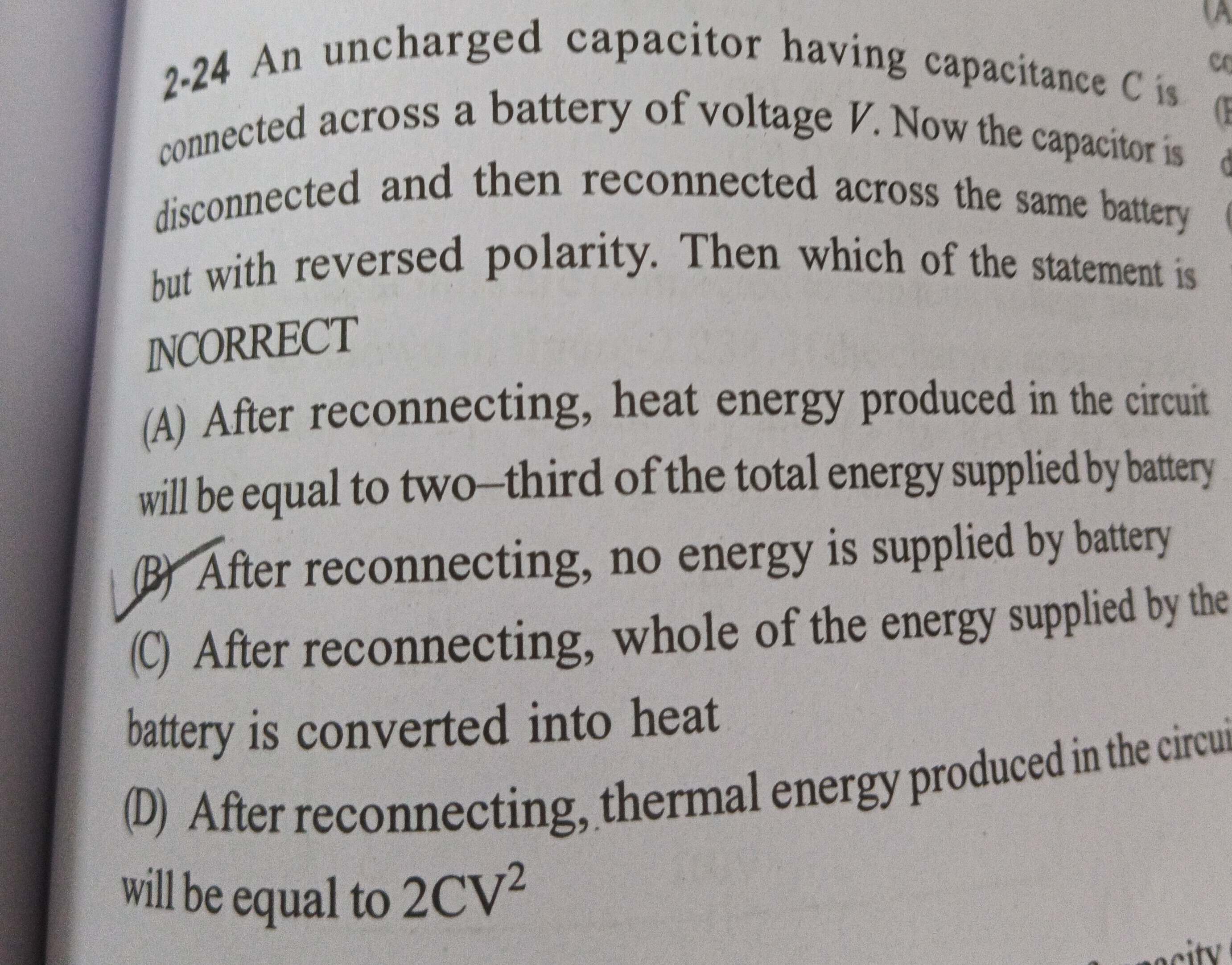Question
Question: 2-24 An uncharged capacitor having capacitance $C$ is connected across a battery of voltage $V$. Now...
2-24 An uncharged capacitor having capacitance C is connected across a battery of voltage V. Now the capacitor is disconnected and then reconnected across the same battery but with reversed polarity. Then which of the statement is INCORRECT

After reconnecting, heat energy produced in the circuit will be equal to two-third of the total energy supplied by battery
After reconnecting, no energy is supplied by battery
After reconnecting, whole of the energy supplied by the battery is converted into heat
After reconnecting, thermal energy produced in the circuit will be equal to 2CV2
After reconnecting, no energy is supplied by battery
Solution
To solve this problem, we need to analyze the energy transfers during two phases:
- Initial charging of the capacitor.
- Reconnection of the capacitor with reversed polarity.
Let the capacitance be C and the battery voltage be V.
Phase 1: Initial Charging
An uncharged capacitor is connected across a battery of voltage V.
- Initial charge on capacitor Qi=0.
- Final charge on capacitor Qf=CV.
- Energy stored in the capacitor Ustored,1=21CV2.
- Charge supplied by the battery ΔQ1=CV.
- Work done by the battery Wbattery,1=V×ΔQ1=V(CV)=CV2.
- Heat produced during initial charging H1=Wbattery,1−Ustored,1=CV2−21CV2=21CV2.
Phase 2: Reconnection with Reversed Polarity
The capacitor is initially charged to V (from Phase 1). Let's assume one plate has charge +CV and the other has −CV. The energy stored is Uinitial,2=21CV2.
Now, it's disconnected and reconnected across the same battery but with reversed polarity. This means the capacitor will eventually be charged to voltage V again, but with the opposite polarity. So, the plate that had +CV will now have −CV, and the plate that had −CV will now have +CV.
-
Final energy stored in the capacitor Ufinal,2=21CV2.
-
Change in stored energy ΔU2=Ufinal,2−Uinitial,2=21CV2−21CV2=0.
-
To reverse the charge on a plate from +CV to −CV, a total charge of 2CV must flow through the circuit. For example, if the plate connected to the positive terminal of the battery initially had charge +CV, after reversal it will be connected to the negative terminal and will acquire charge −CV. The battery effectively draws CV charge from this plate and then supplies CV charge to it in the opposite direction.
Alternatively, consider the plate that was initially at −CV. When reconnected to the positive terminal, it will acquire +CV. The charge supplied by the battery to this plate is (+CV)−(−CV)=2CV.
-
Charge supplied by the battery during reconnection ΔQ2=2CV.
-
Work done by the battery during reconnection Wbattery,2=V×ΔQ2=V(2CV)=2CV2.
-
Heat produced during reconnection H2=Wbattery,2−ΔU2=2CV2−0=2CV2.
Now let's evaluate each statement based on the calculations for "After reconnecting" (Phase 2):
(A) After reconnecting, heat energy produced in the circuit will be equal to two-third of the total energy supplied by battery
- Heat energy produced after reconnecting (H2) = 2CV2.
- "Total energy supplied by battery" in this context can be interpreted as the total energy supplied by the battery throughout the entire process described in the problem (initial charging + reconnection).
- Total energy supplied by battery Wtotal=Wbattery,1+Wbattery,2=CV2+2CV2=3CV2.
- Check the statement: Is H2=32Wtotal? Is 2CV2=32(3CV2)? 2CV2=2CV2. This statement is CORRECT.
(B) After reconnecting, no energy is supplied by battery
- We calculated that energy supplied by battery during reconnection (Wbattery,2) is 2CV2. Since C and V are non-zero, 2CV2 is not zero.
- This statement is INCORRECT.
(C) After reconnecting, whole of the energy supplied by the battery is converted into heat
- Energy supplied by battery during reconnection (Wbattery,2) = 2CV2.
- Heat produced during reconnection (H2) = 2CV2.
- Since Wbattery,2=H2, this statement is CORRECT.
(D) After reconnecting, thermal energy produced in the circuit will be equal to 2CV2
- We calculated that thermal energy produced during reconnection (H2) is 2CV2.
- This statement is CORRECT.
The question asks for the INCORRECT statement. Based on our analysis, statement (B) is the only incorrect one.
